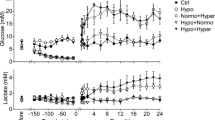Summary
Selective lesions of the noradrenergic locus coeruleus (LC) system have recently been shown to aggravate both ischemic and epileptic brain damage. This study explores the possibility that the LC system also influences hypoglycemic brain injury. Bilateral 6-hydroxydopamine lesions of the LC projection to the forebrain were found to cause no change in the degree of neuronal necrosis in the neocortex, hippocampal formation and caudateputamen following 30 min of reversible insulin-induced hypoglycemic coma. We propose that selective neuronal necrosis in ischemia and status epilepticus is due to the action of excitatory amino acids at synaptic sites, which can be partly counteracted by noradrenaline release from inhibitory LC terminals. In hypoglycemia, excitatory amino acids probably cause brain damage via a local and more diffuse toxic effect which is not significantly influenced by the activation of the LC system.
Similar content being viewed by others
References
Abdul-Rahman A, Agardh C-D, Siesjö BK (1980) Local cerebral blood flow in the rat during severe hypoglycemia, and in the recovery period following glucose injection. Acta Physiol Scand 109: 307–314
Agardh C-D, Carlsson A, Lindquist M, Siesjö BK (1979) The effect of pronounced hypoglycemia on monoamine metabolism in rat brain. Diabetes 28: 804–809
Amaral DG, Sinnamon HM (1977) The locus coeruleus: neurobiology of a central noradrenergic nucleus. Prog Neurobiol 9: 147–196
Auer RN (1986) Progress review: hypoglycemic brain damage. Stroke 17: 699–708
Auer RN, Olsson Y, Siesjö BK (1984a) Hypoglycemic brain injury in the rat. Correlation of density of brain damage with the EEG isoelectric time: a quantitative study. Diabetes 33: 1090–1098
Auer RN, Wieloch T, Olsson Y, Siesjö BK (1984b) The distribution of hypoglycemic brain damage. Acta Neuropathol (Berl) 64: 177–191
Benveniste H, Drejer J, Schousboe A, Diemer NH (1984) Elevation of the extracellular concentrations of glutamate and aspartate in rat hippocampus during transient cerebral ischemia monitored by intracerebral microdialysis. J Neurochem 43: 1369–1374
Blomqvist P, Lindvall O, Wieloch T (1985) Lesions of the locus coeruleus system aggravate ischemic damage in the rat brain. Neurosci Lett 58: 353–358
Chauvel P, Trottier S (1986) Role of noradrenergic ascending system in extinction of epileptic phenomena. Adv Neurol 44: 475–487
Dahlgren N, Lindvall O, Sakabe T, Stenevi U, Siesjö BK (1981) Cerebral blood flow and oxygen consumption in the rat brain after lesions of the noradrenergic locus coeruleus system. Brain Res 209: 11–23
Foote SL, Bloom FE, Aston-Jones G (1983) Nucleus locus ceruleus: new evidence of anatomical and physiological specificity. Physiol Rev 63: 844–914
Ingvar M, Lindvall O, Folbergrova J, Siesjö BK (1983) Influence of lesions of the noradrenergic locus coeruleus system on the cerebral metabolic response to bicuculline-induced seizures. Brain Res 264: 225–231
Lindvall O, Björklund A (1983) Dopamine- and norepinephrine-containing neuron systems: their anatomy in the rat brain. In: Emson PC (ed) Chemical neuroanatomy. Raven Press, New York, pp 229–255
Lindvall O, Auer RN, Siesjö BK (1986) Selective lesions of mesostriatal dopamine neurons ameliorate hypoglycemic damage in the caudate-putamen. Exp Brain Res 63: 382–386
Nevander G, Ingvar M, Lindvall O (1986) Mechanisms of epileptic brain damage: evidence for a protective role of the noradrenergic locus coeruleus system in the rat. Exp Brain Res 63: 439–442
Olney JW (1978) Neurotoxicity of excitatory amino acids. In: McGeer EG, Olney JW, McGeer PL (eds) Kainic acid as a tool in neurobiology. Raven Press, New York, pp 95–121
Olney JW, Gubareff T, Sloviter RS (1983) “Epileptic” brain damage in rats induced by sustained electrical stimulation of the perforant path. II. Ultrastructural analysis of acute hippocampal pathology. Brain Res Bull 10: 699–712
Pulsinelli WA, Brierley JB, Plum F (1982) Temporal profile of neuronal damage in a model of transient forebrain ischemia. Ann Neurol 11: 491–499
Rothman SM (1984) Synaptic release of excitatory amino acid neurotransmitter mediates anoxic neuronal death. J Neurosci 4: 1884–1891
Rothman SM, Olney JW (1986) Glutamate and the pathophysiology of hypoxic-ischemic brain damage. Ann Neurol 19: 105–111
Sandberg M, Butcher SP, Hagberg H (1986) Extracellular over-flow of neuroactive amino acids during severe insulin-induced hypoglycemia: in vivo dialysis of the rat hippocampus. J Neurochem 47: 178–185
Schmidt RH, Ingvar M, Lindvall O, Stenevi U, Björklund A (1982) Functional activity of substantia nigra grafts reinnervating the striatum: neurotransmitter metabolism and (14C)-2-deoxy-D-glucose autoradiography. J Neurochem 38: 737–748
Schwarcz R, Foster AC, French ED, Whetsell WO Jr, Köhler C (1984) Excitotoxic models for neurodegenerative disorders. Life Sci 35: 19–32
Siesjö BK (1981) Cell damage in the brain: a speculative synthesis. J Cereb Blood Flow Metab 1: 155–185
Simon RP, Swan JH, Griffith T, Meldrum BS (1984) Blockade of N-methyl-D-aspartate receptors may protect against ischemic damage in the brain. Science 226: 850–852
Sloviter RS (1983) “Epileptic” brain damage in rats induced by sustained electrical stimulation of the perforant path. I. Acute electrophysiological and light microscopic studies. Brain Res Bull 10: 675–697
Sloviter RS (1987) Decreased hippocampal inhibition and a selective loss of interneurons in experimental epilepsy. Science 235: 73–76
Smith M-L, Auer RN, Siesjö BK (1984) The density and distribution of ischemic brain injury in the rat following 2–10 min of forebrain ischemia. Acta Neuropathol (Berl) 64: 319–332
Wieloch T (1985) Hypoglycemia-induced neuronal damage is prevented by a N-methyl-d-aspartate antagonist. Science 230: 681–683
Wieloch T, Engelsen B, Westerberg E, Auer R (1985) Lesions of the glutamatergic cortico-striatal projections in the rat ameliorate hypoglycemic brain damage in the striatum. Neurosci Lett 58: 25–30
Author information
Authors and Affiliations
Rights and permissions
About this article
Cite this article
Lindvall, O., Auer, R.N. & Siesjö, B.K. Mechanisms of hypoglycemic brain damage. Exp Brain Res 73, 219–223 (1988). https://doi.org/10.1007/BF00279676
Received:
Accepted:
Issue Date:
DOI: https://doi.org/10.1007/BF00279676




